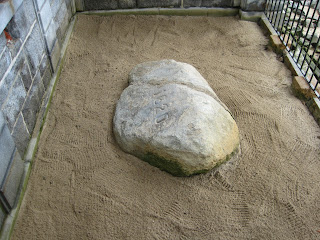 |
| "C'mon Sherman. Let's step into the WABAC machine." |
We first stopped off at the Rock. Oops, sorry, the Rock. For those of you who have never been there, I have provided a picture of said rock above. Now no one is really sure if this rock is the first place that the Pilgrims set foot on land or not. The first person to claim it was did so 120 years after the fact, although he was 94 years old at the time, and it certainly is located within the relatively safe confines of Plymouth Bay and not far from where the settlement was established. You may note that it looks like the rock has been cemented together. That's because in 1774, the townspeople decided to move the rock to the top of the hill to display is as part of Massachusetts' cultural heritage, but I guess it was too heavy or something (over 10 tons), so they split it in half, leaving part of it at the water and moving the rest. In 1880, it was decided that the two halves should be reunited, thus the cement job. As you may imagine, many people wanted a piece of the rock over the years, and it is estimated that the top half is only 1/3 as large as it originally was. Well, as fascinating as looking at a big rock is (even when ensconced within a Roman portico), we didn't hang out too long before wandering over to the Mayflower II.
The Mayflower II was a project (done in the '50's) to rebuild the Mayflower so modern people could really appreciate how entirely insane an idea it was to sail across the ocean to colonize the 'New World'. About 100ft long and 25ft wide, it carried 102 people and 25-30 crew on that voyage. A quick look at the accommodations will quickly persuade you that this is not Royal Carribean. To make matters worse, they hit bad weather which a) blew them off-course (they were aiming for Virginia), b) delayed their arrival until the onset of winter, and c) probably made everyone throw up. The ship over-wintered in Plymouth Bay, and everyone continued to live on board. A disease outbreak killed half the settlers and half the crew. Don't you yearn for simpler times? I know these people were God-fearing Christians (most of them), but I bet they had some choice words for the Mayflower when they finally got off it.
 |
| Makes our house look big. |
Our next stop was Plimoth Plantation, a recreation of the first settlement that the Pilgrims established. I remember having a good time visiting this place on a grey day around Thanksgiving when I was kid in the 1970's, but I didn't remember much of the details. The way it's laid out now, there are two sections: a Wampanoag family homestead, in which they have actual Wampanoag people who dress traditionally and perform traditional tasks (like cooking, farming, and making log canoes), but they do not take on a historical role, they represent their nation as it is today, but are also able to answer questions about their history, as well. (I must point out here that it's always a little awkward when conversing with people your ancestors treated badly.) Then you have the English settlement, wherein all the people are reenactors portraying historical figures. We immediately came upon the apprentice blacksmith who, while we watched, went from flint and steel to a fire hot enough to melt iron in about 10 minutes - it was impressive. He was repairing hinges that day. Hobbes had lots of questions. We also ran into a trader who was about to make a pile of money by buying out some of the investors in the colony - boy could that guy talk. It was a bit of a rainy day, but we enjoyed our stroll through history, seeing how the colonists lived.
 |
| Do NOT get this guy started... |







No comments:
Post a Comment